Electric bus

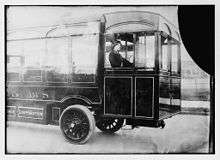
An electric bus is a bus powered by electricity.
There are two main electric bus categories:
- Non-autonomous electric buses:
- The trolleybus is a type of electric bus powered by two overhead electric wires, with electricity being drawn from one wire and returned via the other wire, using two roof-mounted trolley poles.
- The gapbus is a bus without rails or surface power lines, and it can share the road lane with other vehicles as well. Power is supplied over a gap of 12 cm (4.7 in) from a power line embedded in the ground.[1]
- Online Electric Vehicle (OLEV) by KAIST, propelled by a high frequency electric cable buried under the pavement.[2]
- The onboard stored-electricity bus (autonomous electric buses):
For information on buses using a combination of internal combustion engines and electric propulsion, see Hybrid electric buses and Dual-mode buses.
Battery electric bus
One of the most popular electric buses nowadays are the battery electric buses. They have stored the electricity on board in a battery. Today such buses have a range over 200 km with one charge. These buses are usually used because of its limited range as city buses. As a city bus with all costs they are cheaper than a comparable diesel bus.
City driving mostly is accelerating and braking the battery electric bus is superior to diesel buses as it can recharge most of the kinetic energy back to batteries in braking situations. This reduces brake wear but it also improves air quality in city centers.
When operating within a city it is important to minimize the unloaded and rolling weight of the bus. This can be accomplished by using aluminium as the main construction material for a bus. Composite paneling and other lightweight materials can also be used. According to Linkkebus their fully aluminium bus construction is about 3000kg lighter than comparably-sized modern steel buses (curb weight 9500kg) . Reducing weight allows for a greater payload and reduces wear to components such as brakes, tires, and joints bringing costs savings to the operator. [3]
Capabus
The best ultracapacitors can only store about 5 percent of the energy that lithium-ion batteries hold, limiting them to a couple of miles per charge. This makes them ineffective as an energy storage medium for passenger vehicles. But what ultracapacitors lack in range they make up in their ability to rapidly charge and discharge. So in vehicles that have to stop frequently and predictably as part of normal operation, energy storage based exclusively on ultracapacitors begins to make sense.[4]
China is experimenting with a new form of electric bus, known as Capabus, which runs without continuous overhead lines by using power stored in large onboard electric double-layer capacitors, which are quickly recharged whenever the vehicle stops at any bus stop (under so-called electric umbrellas), and fully charged in the terminus.
A few prototypes were being tested in Shanghai in early 2005. In 2006, two commercial bus routes began to use electric double-layer capacitor buses; one of them is route 11 in Shanghai.[5] In 2009, Sinautec Automobile Technologies,[6] based in Arlington, VA, and its Chinese partner, Shanghai Aowei Technology Development Company[7] are testing with 17 forty-one seat Ultracap Buses serving the Greater Shanghai area since 2006 without any major technical problems.[8] Another 60 buses will be delivered early next year with ultracapacitors that supply 10 watt-hours per kilogram.
The buses have very predictable routes and need to stop regularly, every 3 miles (4.8 km), allowing opportunities for quick recharging. The trick is to turn some bus stops along the route into charging stations. At these stations, a collector on the top of the bus rises a few feet and touches an overhead charging line. Within a couple of minutes, the ultracapacitor banks stored under the bus seats are fully charged. The buses can also capture energy from braking, and the company says that recharging stations can be equipped with solar panels. A third generation of the product, will give 20 miles (32 km) of range per charge or better. [4] Such a bus was delivered in Sofia, Bulgaria in May 2014 for 9 months' test. It covers 23 km in 2 charges.[9]
Sinautec estimates that one of its buses has one-tenth the energy cost of a diesel bus and can achieve lifetime fuel savings of $200,000. Also, the buses use 40 percent less electricity compared to an electric trolley bus, mainly because they are lighter and have the regenerative braking benefits. The ultracapacitors are made of activated carbon, and have an energy density of six watt-hours per kilogram (for comparison, a high-performance lithium-ion battery can achieve 200 watt-hours per kilogram), but the ultracapacitor bus is also cheaper than lithium-ion battery buses, about 40 percent less expensive, with a far superior reliability rating.[4][8]
There is also a plug-in hybrid version, which also uses ultracaps.
Proterra's EcoRide BE35 transit bus, called the Ecoliner by Foothill Transit in West Covina, California, is the world’s first heavy duty, fast charge, battery-electric bus. Proterra's ProDrive drive-system uses a UQM motor and regenerative braking that captures 90% of the available energy and returns it to the TerraVolt energy storage system, which in turn increases the total distance the bus can drive by 31-35%. It can travel 30–40 miles on a single charge, is up to 600% more fuel-efficient than a typical diesel or CNG bus, and produces 44% less carbon than CNG.[10]
Future developments
Sinautec is in discussions with MIT's Schindall about developing ultracapacitors of higher energy density using vertically aligned carbon nanotube structures that give the devices more surface area for holding a charge. So far, they are able to get twice the energy density of an existing ultracapacitor, but they are trying to get about five times. This would create an ultracapacitor with one-quarter of the energy density of a lithium-ion battery.[11]
Future developments includes the use of inductive charging under the street, to avoid overhead wiring. A pad under each bus stop and at each stop light along the way would be used.
Pantographs and underbody collectors at bus stops
Pantographs and underbody collectors are integrated in bus stops to quick electric bus recharge, making possible to use a smaller battery on the bus, which reduces the investment and subsequent costs.[12][13][14][15]
Solar-charged
Tindo is an experimental battery electric bus being tested in Adelaide, Australia. The word "Tindo" comes from the aboriginal word for sun. The bus will get its electricity from a photovoltaic system on Adelaide's central bus station. Rides are free as part of Adelaide's public transport system.[16]
Zinc
There is a 40-foot (12.2 m) pure electric bus being developed, using a pre-commercial battery technology. Electric Fuel Corporation is developing and demonstrating a 40-foot (12.2 m) electric bus powered by a zinc air cell,[17] along with an ultracapacitor. The zinc-air energy device, often described as a battery, converts zinc to zinc oxide in a process that provides energy to the bus. The bus is not recharged; instead, the zinc oxide cartridges are swapped out for new zinc ones. This bus has shown a range of over 100 miles (160 km) in testing and has been demonstrated in Las Vegas, Nevada. However, this technology is in the development phase, and several major hurdles must be overcome before it can be adopted for transit fleet use, including available refueling infrastructure or use in bus stations.[18]
Onboard solar panels
Air conditioning
Solar panels and supercapacitors are used in some electric buses to power the specific air conditioning circuit.
School Buses
In 2014, the first production model all-electric school bus was delivered to the Kings Canyon Unified School District in California’s San Joaquin Valley. The Class-A school bus was built by Trans Tech Bus, using an electric powertrain control system developed by Motiv Power Systems, of Foster City, CA. The bus was one of four the district ordered. The first round of SST-e buses (as they are called) is partly funded by the AB 118 Air Quality Improvement Program administered by the California Air Resources Board.
The Trans Tech/Motiv vehicle has passed all KCUSD and California Highway Patrol inspections and certifications. Although some diesel hybrids are in use, this is the first modern electric school bus approved for student transportation by any state.
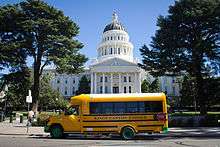
Since 2015 the Canadian manufacturer Lion Bus offers a full size school bus, with a body made out of composites. It is a regular production version that is built and shipped in volume since early 2016.
Makers and models
- Linkkerbus
- Lion Bus eLion
Transit use
- For information on where trolleybuses are in use, see Trolleybus usage by country and List of trolleybus systems.
Transit authorities that use battery buses or other types of all-electric buses, other than trolleybuses:
Asia
Malaysia
India
- India's first electric bus was launched in Bengaluru in 2014.[19]
- In October 2016, Ashok Leyland, launched First 100% India-made electric bus. The series has been named Circuit and it can carry 35 to 65 persons at a time.[20]
China
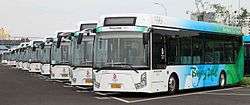
As of 2016, greater than 40,000 buses are being put into service per year in China.[21]
- Beijing
- Changsha (BYD x 180 vehicles) [22]
- Haikou (BYD) [23]
- Shanghai (capabuses).
- Shaoguan (BYD) [24]
- Shenzhen (BYD x 200 vehicles) [25]
- Tianjin (BYD) [26]
- Xi'an (BYD) [27]
- Yancheng.[28]
Japan
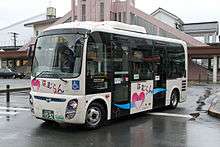
- Community Bus "Hamurun" (Operated by Nishi Tokyo Bus) in Hamura, Tokyo since March 10, 2012[29]
- Community Bus "Sumida Hyakkei" (Operated by Keisei Bus) in Sumida, Tokyo since March 20, 2012[30]
- Kitakyushu City, Japan.[31]
South Korea
- Seoul has 15 electric buses nicknamed "Peanut Bus" for their shape, transferring people from subway stations in downtown to the N Seoul Tower, circulating Mt. Namsan.[32]
- Seoul's Gangnam District will have 11 electric buses in operation from February 2013 and 270 electric buses by the end of 2013, increasing to 400 buses by 2014.[33] At least 3,500 electric buses will be introduced in phases until 2020, which will account for half of Seoul's bus fleet.[34]
- Gumi will have the world's first wireless electric bus, known as Online Electric Vehicle, in operation from July 2013 developed by KAIST. Electricity is wirelessly fed into the bus from the tracks.[2][35]
- Pohang will have automatically battery switching electric buses in operation from July 2013. Unlike conventional plug-in charging buses, the battery pack is automatically swapped with a fully charged one before complete drainage.[36]
Europe
Finland
- Espoo Cobus EL2500 (bus 11 Friisilä-Tapiola Centre)
- Espoo (Linkker 2 vehicles, Bus 11 line Tapiola centre-Friisilä)[37]
France
Great Britain
- 51 electric buses for the 507 and 521 bus routes in London, delivered jointly by BYD and ADL.[39]
- Strathclyde Partnership for Transport have begun running battery-powered electric buses on one route in Glasgow, between George Square and the Transport Museum. [40]
Italy
- Gruppo Torinese Trasporti — Turin, Italy
Netherlands
- Netherlands: 6 all-electric BYD buses in April 2013 on the island of Schiermonnikoog. Right now, there are 52 electric buses driving in the Netherlands. Starting December 11, with the new bus schedule for 2017, Hermes will be running 43 buses to the bus transport of Eindhoven. Arriva will run 16 electric buses on Vlieland, Ameland and Schiermonnikoog.
Russia
- In 2014 in Chelyabinsk began to run electric buses (hybrid trolleybus and electric car). Moves up to 30 kilometers on routes unequipped wires to distant parts of the city.[41]
Spain
- Empresa Malagueña de Transportes (EMT), S.A.M[42]
- Empresa Municipal de Transportes de Madrid (20 all-electric and 20 hybrid diesel-electric buses)[43]
- Councillor for the Environment, Figueres [44]
- León: Minibus Tecnobus Gulliver [45][46]
- Seville [45]
Sweden
- Västtrafik is running 10 electric Volvo buses in Gothenburg on route 55[47]
Switzerland
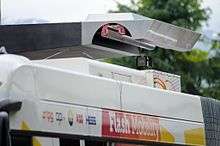
- transport public genève (tpg) introduce TOSA Flash Mobility, Clean City, Smart Bus[48] a new system of mass transport with electric “flash” recharging of the buses at selected bus stops.[49]
North America
Canada
Ontario
Québec
- Réseau de transport de la Capitale, Quebec City's public transit authority has integrated 8 electric buses to its fleet in 2008 to serve the Old City.[51] The Tecnobus Gulliver buses can carry up to 20 passengers and runs on $3.25 worth of electricity per day.[52]
- Montreal, bus fleet going all-electric by 2025.[53]
United States
Federal Transit Administration Clean Air Program [54]
- Anaheim, CA
- Atlanta, GA (at Emory University)
- Chattanooga, TN
- Colorado Springs, CO
- Dayton, OH
- Hampton, VA
- Los Angeles, CA
- Louisville, KY
- Miami Beach
- Mobile, AL
- Nashville, TN
- New Haven, CT
- Pomona, CA
- Reno, NV
- Santa Barbara, CA
- San Antonio, TX
- San Francisco, where electric trolleybuses are already commonplace on most SF Muni routes.
- Seattle, WA
- Seneca, SC
- Stockton, CA
- Tallahassee, FL
- Worcester, MA
California
There is a Californian mandate (Zero Emission Bus, in short, ZBus) that 15% of new buses after 2011 be electric.[55] The ZBus Regulation is part of the Fleet Rule for Transit Agencies, which is also referred to as the Public Transit Agencies Regulation.[56][57]
South America
Aruba
- Oranjestad (BYD) [58]
Brazil
Chile
- Santiago (BYD) [60]
- Valparaiso (BYD) [60]
Colombia
Uruguay
- Montevideo (BYD x 200 vehicles) [62]
See also
References
- ↑ "Korean electric vehicle solution". Gizmag.com. Retrieved 2010-07-28.
- 1 2 OLEV
- ↑ http://www.linkkerbus.com/naytasivu/Lightweight+bus+construction/5
- 1 2 3 "Next Stop: Ultracapacitor Buses". Technology Review. Retrieved 2010-07-28.
- ↑ (in Chinese, archived page)
- ↑ "SINAUTEC, Automobile Technology, LLC". Sinautecus.com. Retrieved 2010-07-28.
- ↑ "Aowei Technology". Aowei.com. Archived from the original on 2010-01-25. Retrieved 2010-07-28.
- 1 2 "Ultracapacitor Buses Work... As Long as You have Lots of Quick-Charge Stations". TreeHugger. Retrieved 2010-07-28.
- ↑ http://www.chariot-electricbus.com/pilot-projects/sofia/
- ↑ http://www.proterra.com
- ↑ "Next Stop: Ultracapacitor Buses". Technology Review. Retrieved 2010-07-28.
- ↑ Large-capacity, flash-charging, battery-powered pilot bus takes to the street.
- ↑ Current collectors for electric busses
- ↑ A Giant Charger That Juices Up Electric Buses in Three Minutes
- ↑ Ultrafast Electric Bus Charging, Opbrid
- ↑ "All-Electric, Solar-Powered, Free Bus!!!". Ecogeek.org. Archived from the original on 2009-09-08. Retrieved 2010-07-28.
- ↑ http://www.electric-fuel.com
- ↑ http://www.fta.dot.gov/documents/Electric_Drive_Bus_Analysis.pdf
- ↑ "India's first electric bus launched in Bangalore - The Times of India". The Times Of India.
- ↑ http://www.rajras.in/index.php/ashok-leyland-launched-first-india-made-electric-bus/
- ↑ http://cleantechnica.com/2015/11/26/electric-bus-adoption-taking-off-china/
- ↑ "Chinese carmaker BYD's Changsha facility becomes the country's leading new energy vehicle base". AMTonline. 2012-09-28. Retrieved 2012-10-26.
- ↑ "比亚迪k9纯电动大巴海口运行状况良好_中国电动汽车网站资讯频道" (in Chinese). Ddc.net.cn. 2011-10-11. Retrieved 2012-10-26.
- ↑ First Thailand Orders for Long-range BYD e6 EV". Global Renewable News. 2012-09-10. Retrieved 2012-10-26.
- ↑ "Bus Technology Comparisons Released by Clinton Climate Initiative C40 Cities Program - WSJ.com". Online.wsj.com. 2012-10-06. Retrieved 2012-10-26.
- ↑ 比亚迪天津建纯电动公交基地_汽车_凤凰网 (in Chinese). Auto.ifeng.com. Retrieved 2012-10-26.
- ↑ 陕西:西安首批比亚迪电动公交车投入运营 -中国客车信息网(客车资讯 客车新闻 客车动态 客车门户 客车企业 客车产品) (in Chinese). Chinabus.info. Retrieved 2012-10-26.
- ↑ "Zonda New Energy BRT City Bus served Yancheng". ZondaBus. Archived from the original on 2012-03-06. Retrieved 2010-07-28.
- ↑ "【EVバス運行開始】定期路線として全国初の運用開始". Response. (in Japanese). 2012-03-11. Retrieved 2012-03-14.
- ↑ 墨田区内循環バス「すみまるくん」「すみりんちゃん」、3月20日運行開始 /東京. Yahoo! Japan News (in Japanese). 2012-03-07. Retrieved 2012-03-14.
- ↑ Mitsubishi to supply two electric buses in Kitakyushu City, Japan
- ↑ "Quick Links". CNN.
- ↑ http://news.naver.com/main/read.nhn?mode=LSD&mid=sec&sid1=103&oid=001&aid=0005299448
- ↑ http://rpm9.etnews.com/news/articleView.html?idxno=6955
- ↑ http://news.khan.co.kr/kh_news/khan_art_view.html?artid=201301102209555&code=940100
- ↑ http://www.breaknews.com/sub_read.html?uid=250841§ion=sc2
- ↑ http://www.espoo.fi/fi-FI/Ensimmaiset_kotimaiset_pikaladattavat_sa%2880532%29
- ↑ La RATP inaugure sa première ligne de bus standard 100% électrique Template:Frr
- ↑ http://insideevs.com/byd-scores-europes-largest-electric-bus-fleet-order/
- ↑ http://www.spt.co.uk/documents/SP280314_agenda8.pdf
- ↑ "В Челябинске начал курсировать электробус.".
- ↑ http://www.emtmalaga.es/inter/emt/interior_detalle.jsp?id=2460&tipo=20. Retrieved November 6, 2008. Missing or empty
|title=(help) - ↑ http://www.noticiasdeautobus.es/2008/06/18/el-ayuntamiento-refuerza-la-escuadra-de-la-emt-con-210-nuevos-autobuses/ (Spanish)
- ↑ http://www.energie-cites.eu/db/figueres1_577_en.pdf
- 1 2 Periodista Digital. "El autobús eléctrico de El Ejido es el 1º de la comunidad y el 2º en España". Reporterodigital.com. Retrieved 2010-12-12.
- ↑ "Our Products - Tecnobus - Autobus e minibus per il trasporto pubblico". Tecnobus.it. 2006-05-01. Retrieved 2010-12-12.
- ↑
- ↑ TOSA2013 The project aims to introduce a new system of mass transport with electric “flash” recharging of the buses at selected stops (overhead conductive charging)
- ↑ http://www.tosa2013.com/en (Chamorro)
- ↑ Business Wire (2012-05-04). "City of Windsor First in North America to Launch BYD Environmentally-Friendly Electric Buses". Business Wire. Retrieved 2012-10-26.
- ↑ "L'Écolobus sillonne les rues de la ville". Québec Hebdo. Québec. June 13, 2008. Retrieved 2010-07-31.
- ↑ "Écolobus". Réseau de transport de la Capitale (in French). Québec. Retrieved 2010-07-31.
- ↑ Loveday, Eric (2010-05-24). "Montreal's 1,300-plus bus fleet going all electric by 2025 — Autoblog Green". Green.autoblog.com. Retrieved 2010-07-28.
- ↑ "Design Guidelines for Bus Transit Systems Using Electric and Hybrid Electric Propulsion as an Alternative Fuel". Transit-safety.fta.dot.gov. 2001-12-15. Archived from the original on June 10, 2010. Retrieved 2010-07-28.
- ↑ Yoney, Domenick (2009-02-08). "Proterra touring California with fast-charging electric bus — Autoblog Green". Green.autoblog.com. Retrieved 2010-07-28.
- ↑ "Zero Emission Buses". Arb.ca.gov. Retrieved 2010-07-28.
- ↑ "Transit Top Page: Public Transit Agencies". Arb.ca.gov. Retrieved 2010-07-28.
- ↑ "Aruba Partners with BYD in Zero-Emissions Initiative, Energy Independence by 2020<002594.SZ>". Reuters.com. 2013-06-11. Retrieved 2013-06-15.
- ↑ "Sao Paulo, Brazil, Mayor Confirms Plan for BYD Electric Buses". finance.yahoo.com. 2012-10-08. Retrieved 2012-11-13.
- 1 2 "BYD K9 Electric Buses Drive in San Diego-news-www.chinabuses.org". Chinabuses.org. Retrieved 2012-10-26.
- ↑ "Future Rapid Transportation System Unveiled in Bogotá". Bloomberg.com. 2013-03-18. Retrieved 2013-03-21.
- ↑ "BYD bringing electric buses to Uruguay; targeting more than 500 by 2015". Green Car Congress. 2012-07-19. Retrieved 2012-10-26.
External links
| Wikimedia Commons has media related to Electrically-powered buses. |
- Linkkerbus
- Electric buses, Citytransport.
- Electric buses, Clean Air Initiative (CAI), World Bank
- (PDF) http://www.arb.ca.gov/regact/zbus06/res0628.pdf. Missing or empty
|title=(help) (28.2 KB) (California Air Resources Board) - Nanobus
- The Electric Tbus Group
- Advanced buses
.png)